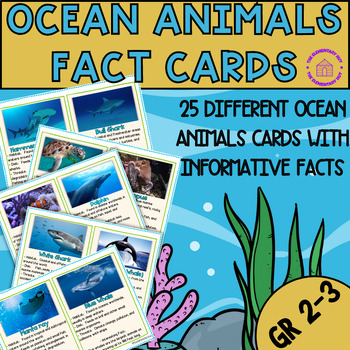Fact Cards About Ocean Animals - Marine life Printables for 2nd&3rd Grades
- PDF
Also included in
- The ultimate bundle you will need for your oceans unit! Packed with five captivating resources, this bundle is designed to make learning about ocean animals simple while keeping your students engaged and excited about science. What's Included:Ocean Animals Fact Cards:Dive into a sea of knowledge witPrice $15.75Original Price $17.50Save $1.75
Description
These Marine Animals Fact Cards are a great addition to your Ocean unit! This printable resource is designed to engage and educate students about various marine animals. It can be used as an informational text for reading and writing or for Ocean-themed research-based projects. With 25 cards in total, each card provides valuable information about a specific marine animal's habitat, diet, threats, and interesting facts. I have used them in my own classroom, and the kids loved them!
Ocean Animals Included in the Cards:
- White Shark, Orca (Killer Shark), Clownfish, Dolphin, Lionfish, Triggerfish, Sea Turtle, Octopus, Jellyfish, Seahorse, Starfish, Crab, Manta ray, Blue Whale, Humpback Whale, Squid, Pufferfish, Walrus, Seal, Shrimp, Hammerhead Shark, Bull Shark,Beluga Whale, Sea Lion, Eel.
These marine animals fact cards offer numerous benefits for students across various subjects and activities. Here's how they can be utilized:
1. Research: Students can use the fact cards as a starting point for their research on marine animals. They can delve deeper into each animal's habitat, diet, and threats, gathering additional information from books or online sources.
2. Informative Writing: The fact cards serve as excellent prompts for informative writing. Students can choose a marine animal, gather information from the card, and write a detailed and engaging informative text about it. This activity helps develop research and writing skills.
3. Science Projects: The fact cards can be a valuable resource for science projects related to marine life. Students can select a marine animal, conduct further research, and create presentations, dioramas, or even experiments based on their chosen animal's characteristics.
4. Trading Cards: The fact cards can also be used as trading cards, adding an element of fun and excitement to the learning process. Students can trade cards with their peers, discussing the information on each card and expanding their knowledge about different marine animals
You can also incorporate the fact cards into a scavenger hunt or quiz game, challenging students to find specific information or answer questions based on the cards.
By utilizing these Marine Animals Fact Cards, students will not only gain knowledge about various marine animals but also develop research, writing, and critical thinking skills. Let the exploration of the fascinating world of marine life begin!
FOLLOW ME to be the first to know about my new discounts, freebies, and product launches.
Don't forget to leave a review to help me improve the quality of my resources, you can also earn back some credit on your next purchase!
Note - Fonts and Clip art credits in all my products are used in accordance with their licensing agreements.





